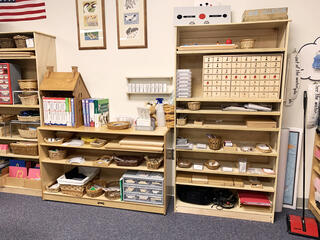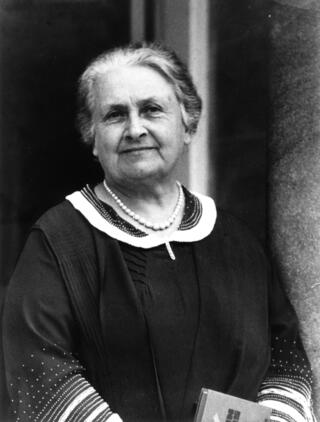WHAT IS MONTESSORI?
Maria Montessori (1870-1952) was born to a well-respected family, and was expected to grow up to fulfill the traditional role of the Italian woman. Instead, she pursued an advanced degree at the University of Rome and became the first woman physician to graduate in Italy.
Her interests drew her to work with children, initially those who were disadvantaged and had special needs. Dr. Montessori’s Casa dei Bambini or House of Children, was a radical departure from traditional schools and gained immediate worldwide recognition for the Montessori system.
In an environment tailored to children’s needs, with adults whose profound respect for the spiritual child and pedagogical techniques resembled guidance more than direct teaching, and an atmosphere of freedom within limits, these “disadvantaged” children flourished in their development of independence, self-discipline, social grace and cognitive accomplishment.
 A PREPARED ENVIRONMENT
A PREPARED ENVIRONMENT
The “prepared environment” is a key principle of Montessori philosophy referring to the physical, instructional, and spiritual aspects of the classroom, the teachers and the children. Spiritual, in this sense, is a secular reference to peace of mind, enabling the teacher and student to engage in learning in a calm environment and manner.
Dr. Maria Montessori’s “follow the child” philosophy is often misinterpreted to mean that children are allowed to do whatever they choose in a classroom and that the class lacks structure. In fact, children are allowed freedom within limits to develop to their full potential, guided by Montessori-credentialed teachers, in a classroom that has specific Montessori materials and lessons in the areas of language arts, mathematics, practical life, and cultural subjects. The classroom is structured to allow the students independence while sticking to a set cirriculum.
FREQUENTLY ASKED QUESTIONS
- Why does Tomah Area School District have a Montessori Charter School?
- Tomah area school is committed to transforming education to ensure the Tomah School District remains a school district of choice for students and their families by equipping students with 21st Century Skills needed for college and career readiness. One of the many ways Tomah Area School District is carrying out this goal is by offering another choice for families in elementary education. We know all students learn differently, and Montessori education has shown to be an excellent path for many students, particularly because of its emphasis on self-directed learning.
- Tomah area school is committed to transforming education to ensure the Tomah School District remains a school district of choice for students and their families by equipping students with 21st Century Skills needed for college and career readiness. One of the many ways Tomah Area School District is carrying out this goal is by offering another choice for families in elementary education. We know all students learn differently, and Montessori education has shown to be an excellent path for many students, particularly because of its emphasis on self-directed learning.
- What is meant by “Spiritual” Development of the Child?
- Inner peace and calm are essential to a child’s readiness to learn and their ability to concentrate. TAMS is a secular school and spiritual development of a child starts in the classroom where materials are carefully organized on shelves according to a curriculum sequence and with a Montessori-trained faculty. Grace and courtesy, essential elements of a Montessori classroom, are emphasized and modeled by the adults. Maria Montessori’s first classroom, opened in 1907, was named Casa dei Bambini, or Children’s House, because she believed the classroom belongs to the children where they work and learn in a secure, safe, and supportive environment.
- Inner peace and calm are essential to a child’s readiness to learn and their ability to concentrate. TAMS is a secular school and spiritual development of a child starts in the classroom where materials are carefully organized on shelves according to a curriculum sequence and with a Montessori-trained faculty. Grace and courtesy, essential elements of a Montessori classroom, are emphasized and modeled by the adults. Maria Montessori’s first classroom, opened in 1907, was named Casa dei Bambini, or Children’s House, because she believed the classroom belongs to the children where they work and learn in a secure, safe, and supportive environment.
- Why aren’t there Grades in a Montessori school?
- Children in a Montessori environment work without competition and coercion. Each child works at his or her own pace, enabling the child an opportunity to explore intellectual challenges for the sake of learning and accomplishment. Assessment in Montessori is integrated into teaching and lesson planning through a variety of methods such as observation, recordkeeping of a child’s practice and mastery of lessons, portfolios, written reports, presentations, and dialogue. Benchmark testing occurs three times each year for all students. State testing is administered once a year to students in 3rd grade and above. Assessment is a crucial and everyday part of the TAMS approach. Teachers integrate assessment with their lesson planning allowing them to “follow the child” according to his or her progress.
- Children in a Montessori environment work without competition and coercion. Each child works at his or her own pace, enabling the child an opportunity to explore intellectual challenges for the sake of learning and accomplishment. Assessment in Montessori is integrated into teaching and lesson planning through a variety of methods such as observation, recordkeeping of a child’s practice and mastery of lessons, portfolios, written reports, presentations, and dialogue. Benchmark testing occurs three times each year for all students. State testing is administered once a year to students in 3rd grade and above. Assessment is a crucial and everyday part of the TAMS approach. Teachers integrate assessment with their lesson planning allowing them to “follow the child” according to his or her progress.
- Why are there children of different ages in the same Montessori Classroom?
- Dr. Montessori observed that adult society is represented by multi-age beings and the benefits of peer observation and learning and collaboration could be successfully implemented in a classroom. Young children flourish more rapidly in classes that span two or three years. Mixed-age grouping encourages older children to assist and mentor their younger classmates, while the younger ones look forward to moving on to the more challenging activities they see around them. Most importantly, the mixed-age grouping allows children to master work at their own pace. Students move on to advanced topics as they are academically prepared for them, not simply when they reach a given age level.
- Dr. Montessori observed that adult society is represented by multi-age beings and the benefits of peer observation and learning and collaboration could be successfully implemented in a classroom. Young children flourish more rapidly in classes that span two or three years. Mixed-age grouping encourages older children to assist and mentor their younger classmates, while the younger ones look forward to moving on to the more challenging activities they see around them. Most importantly, the mixed-age grouping allows children to master work at their own pace. Students move on to advanced topics as they are academically prepared for them, not simply when they reach a given age level.
- What Special Training do the Montessori Teachers Have at TAMS?
- Teachers receive their AMS Montessori teaching credential from MMTTC (Midwest Montessori Teacher Training Center).
- Montessori teachers study a rigorous curriculum of child development and Montessori philosophy as well as specific uses of the Montessori classroom materials. A Montessori-credentialed teacher is trained to recognize a child’s readiness according to age, ability, and interest in a specific lesson, and is prepared to guide individual progress.
- How can I create a Montessori Environment in my home?
- Children need a sense of belonging, and they get it by participating fully in the routines of everyday life. “Help me do it by myself” is the life theme of the preschool child. You can find ways for your child to participate in meal preparation, cleaning, gardening, and caring for clothes, shoes, and toys. Providing opportunities for independence is the surest way to build your child’s self-esteem.

